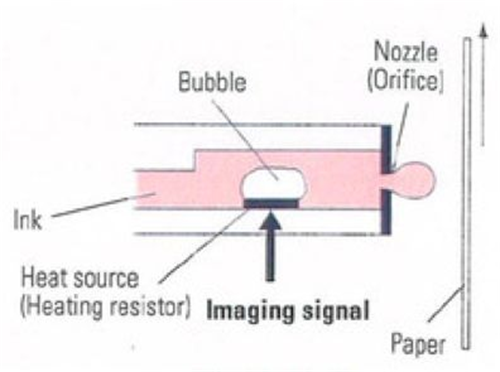Inkjet printing technology is a new non-contact, non-pressure, non-plate printing technology, which can realize printing by inputting the information stored in the electronic computer into the inkjet printer. According to the working principle, inkjet printing technology can be divided into two types: solid inkjet and liquid inkjet. The working mode of solid inkjet is mainly dye sublimation, but the cost is high; and the main working mode of liquid inkjet printer is divided into thermal and micro piezoelectric, and these two technologies are still the current inkjet. The mainstream technology in the printing market, in this issue, we mainly introduce the thermal bubble inkjet printing technology.

How Thermal Inkjet Printing Technology Works
The heat generated by the heating device causes the ink to boil and the force of the bubbles to spit out the ink

Thermal inkjet printing technology is a high temperature and high pressure printing technology by heating nozzles to generate bubbles in the ink, and the bubbles squeeze the ink onto the printing substrate.
The working principle of thermal inkjet printing technology is: using thin film resistors, the ink with a volume of less than 5uL is instantly heated to above 300 ℃ in the ink ejection area, forming countless tiny bubbles, and the bubbles are rapidly 10 us) coalesced into large bubbles and expanded, forcing ink droplets out of the nozzle. After the bubble continues to grow for a few microseconds, it disappears back to the resistor, and as the bubble disappears, the ink in the nozzle also retracts. Then, due to the suction force generated by the surface tension of the ink, new ink will be drawn to replenish the ink ejection area for the next cycle of printing.
Since the ink near the nozzle is continuously heated and cooled, the accumulated temperature continuously rises to 30~50℃, so it is necessary to use the ink circulation in the upper part of the ink cartridge to cool down, but in the long-term printing process, the ink in the entire ink cartridge will still remain at 40 ~50℃ or so. Since thermal inkjet printing is carried out at higher temperature, the ink must have low viscosity (less than 1.5mPa.s) and high surface tension (more than 40mN/m) to ensure long-term Continuous high-speed printing.
Advantages of Thermal Inkjet Printing Technology
thermal inkjet printing technology generally uses an ink system mixed with water-based and oil-based dyes, which can achieve good printing quality whether it is used in home printers or commercial printers. By reducing the ink droplet ejection area and integrating circuit circulation technology, the ink droplet volume of inkjet printers using thermal inkjet printing technology in the future will be smaller, and the frequency of ink droplets will be higher, which can produce more abundant ink droplets. Harmonized colors and smoother halftones. thermal inkjet printing technology meets the basic elements of low operating frequency, high nozzle count and resolution of a single print required for high-speed printing, which can improve printing speed and printer work efficiency, and integrated circuit technology can also continue to reduce printing costs.
In addition, the print head using thermal inkjet printing technology will generate pressure due to the action of thermal bubbles between the ink cartridge and the ink. Therefore, the ink cartridge and the nozzle are required to form an integrated structure. When the ink cartridge is replaced, the print head is updated at the same time. Users no longer have to worry about the problem of clogging the nozzle. However, this also causes the cost of consumables to be relatively expensive
Disadvantages of Thermal Inkjet Printing Technology
The nozzle using thermal inkjet printing technology works in a high temperature and high pressure environment for a long time, and the nozzle is seriously corroded, and it is easy to cause ink droplet splashing and nozzle blockage.
In terms of printing quality, because the ink needs to be heated during use, the ink is prone to chemical changes at high temperatures, and its properties are unstable, and the color authenticity will be affected to a certain extent; on the other hand, since the ink is ejected through air bubbles, The directionality and volume of the ink droplets are difficult to control, and the edges of the printed lines are easy to be uneven, which affects the printing quality to a certain extent.
Post time: Apr-15-2022


